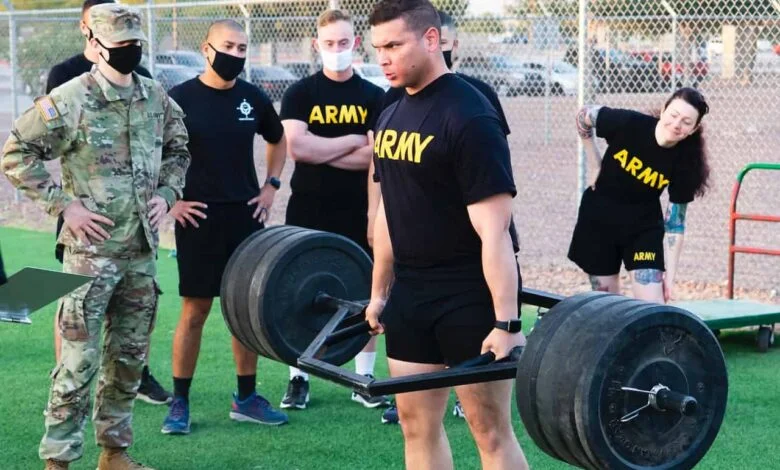Army Physical Fitness Test Guaranteeing Preparation and Ability

The Military Physical Fitness Test (APFT) remains as a foundation for assessing the physical preparation of fighters. Over a simple proportion of physical ability it’s a complete evaluation guaranteeing fighters have the strength perseverance and dexterity expected for their obligations.
Components of the APFT
The test comprises three primary components:
- Push-Ups: Assess chest area strength and perseverance.
- Sit-Ups: Measures center strength and perseverance.
- 2-Mile Run: Surveys cardiovascular perseverance and general endurance.
Each component has specific standards with the overall score indicating a soldier’s physical fitness level.
Importance of the APFT
Battle Availability: The APFT ensures that soldiers are physically prepared for combat. The test ensures that soldiers have the endurance, strength, and agility necessary for combat.
Wellbeing and Prosperity: Past battle preparation the APFT energizes a culture of fitness and prosperity among warriors. Ordinary actual work further develops execution as well as adds to generally speaking well-being and flexibility.
Authority and Discipline: Satisfying APFT guidelines requires devotion and discipline. Soldiers must train consistently fostering traits essential for leadership and teamwork.
Preparing for Success
Training Regimens: To excel in the APFT soldiers engage in targeted training programs. These regimens focus on building strength endurance and speed tailored to meet the test’s requirements.
Nutrition and Rest: A balanced diet and sufficient rest are pivotal. Proper nutrition fuels performance during training and the test while adequate rest aids in recovery and enhances overall readiness.
Mental Preparation: Beyond physical training mental resilience is crucial. Soldiers develop mental toughness through training and preparation aiding in pushing through physical challenges.
Adaptations and Evolutions
The military constantly evaluates and adapts fitness standards to reflect evolving needs. This includes considerations for gender-neutral standards recognizing individual capabilities and adjusting protocols to accommodate varying conditions.
Possibilities as well as Challenges
While the APFT serves as an invaluable tool challenges exist. Some soldiers may struggle to meet standards due to various reasons such as injuries or differing body types. Addressing these challenges involves tailored training and support to ensure every soldier has the opportunity to succeed. Moreover, the test’s relevance in evaluating overall readiness continues to evolve. New methodologies and technologies may offer more accurate and comprehensive assessments potentially reshaping how fitness is measured in the military.
This happens if a soldier fails the APFT
At the point when warriors neglect to fulfill the base guidelines set by the Army Physical Fitness Test (APFT) there are a few potential outcomes they could confront:

- Retesting: Regularly officers who bomb the APFT are permitted to retest after a specific period permitting them one more opportunity to fulfill the base guidelines. The retest often occurs within a reasonable timeframe providing individuals with an opportunity to improve their fitness level and achieve a passing score.
- Medicinal Preparation: Fighters who bomb the APFT might be expected to go through healing actual preparation. This particular preparation is aimed at assisting people with improving their physical fitness zeroing in on regions where they didn’t fulfill the necessary guidelines. Medicinal instructional courses are intended to further develop strength perseverance and by and large, fitness to guarantee that troopers can meet the vital benchmarks.
- Administrative Actions: In some cases, failure to meet APFT standards might result in administrative actions. These actions can vary based on the unit’s policies the frequency of failed tests and individual circumstances. Administrative actions could include counseling a review of the soldier’s performance or even more severe measures in instances of repeated failures such as a negative impact on promotions potential reassignment or in rare cases separation from the military.
Soldiers with physical limitations or injuries
Soldiers who have recorded ailments or wounds that might influence their capacity to play out specific activities or fulfill guideline wellness prerequisites during the Army Physical Fitness Test (APFT) can get transitory or long-lasting profiles.
- Brief Profiles: These profiles are given for a predetermined span and are intended for warriors who have transient wounds or ailments that briefly influence their physical fitness. Temporary profiles outline specific limitations or alternative exercises that the soldier can perform instead of the standard APFT components. These alternatives are designed to accommodate the individual’s condition while maintaining a level of physical activity appropriate for their recovery.
- Permanent Profiles: Soldiers with long-term or permanent medical conditions that significantly impact their ability to perform standard exercises may receive permanent profiles. These profiles establish adjusted fitness standards or alternative exercises that are more suitable for the soldier’s condition. They ensure that the soldier can maintain physical readiness within their capabilities while considering their medical circumstances.
These profiles are granted based on medical evaluations and recommendations from healthcare providers. They aim to balance the soldier’s health needs with the requirement for maintaining physical readiness within the Army. Soldiers with temporary or permanent profiles are still expected to maintain an appropriate level of physical fitness based on the adjusted standards outlined in their profiles. This allows them to contribute to the military’s mission while taking into account their medical limitations. Profiles are periodically reviewed to assess any changes in the soldier’s condition and adjust fitness standards accordingly.
Often must soldiers take the APFT
The Army orders that soldiers go through the Army Physical Fitness Test (APFT) two times each year as a standard practice to evaluate and stay aware of their Physical Fitness levels. Normally these assessments are planned for the spring and fall.
- Spring Test: The first APFT of the year often occurs during the spring months providing an initial evaluation of a soldier’s physical readiness after the winter period. This timing allows soldiers to gauge their fitness levels at the beginning of the training cycle helping them set goals for improvement and track progress throughout the year.
- Fall Test: The second APFT usually takes place in the fall offering a follow-up assessment toward the end of the training cycle. By conducting the test in the fall soldiers can measure their fitness gains or any changes that have occurred over the training year. This timing also ensures that soldiers maintain consistent fitness standards throughout different seasons and training regimens.
The APFT’s semi-annual administration serves several purposes:
- Assessment of Readiness: It provides a systematic and regular evaluation of a soldier’s physical readiness ensuring that they meet the minimum fitness standards required for their roles within the Army.
- Goal Setting and Improvement Tracking: Soldiers can use the results from these tests to set personal fitness goals and track their progress over time. It permits people to recognize regions for development and work toward upgrading their general physical fitness.
- Consistency and Accountability: By conducting the APFT at regular intervals the Army ensures a consistent measurement of fitness levels across the force. It also holds soldiers accountable for maintaining their physical readiness throughout the year.
APFT ties into a soldier’s career progression
Meeting Satisfying or outperforming the guidelines set by the Army Physical Fitness Test (APFT) holds huge significance for a warrior’s professional movement inside the military. This accentuation on fulfilling fitness guidelines stretches out past simple physical capacity it encapsulates a trooper’s obligation to status a central part of military help.
- Proficient Headway: The APFT fills in as a benchmark for assessing a fighter’s devotion to keeping up with actual status which is considered a central component of being a skilled and successful individual from the military. Satisfying or surpassing these guidelines is emphatically an officer’s obligation to their calling.
- Responsibility and leadership: Soldiers who reliably meet or surpass the APFT principles frequently show areas of strength for a disciplined initiative and obligation. These characteristics are profoundly esteemed inside the tactical construction and are fundamental for professional success in positions of authority.
- Functional Availability: Physical fitness straightforwardly influences a trooper’s capacity to perform undertakings really in different functional conditions. Keeping an elevated degree of wellness guarantees that fighters are ready to deal with the actual requests of their obligations, adding to in general functional status.
- Proficient Picture: Fulfilling fitness guidelines impacts a fighter’s expert capacities as well as adds to their general picture inside the tactical local area. Warriors who focus on physical fitness show a promise to greatness which can emphatically influence their standing among companions and bosses.
- Profession Potential open doors: Progression inside the military frequently includes contemplations of past work execution alone. Satisfying APFT guidelines can improve a warrior’s qualification for extraordinary task advancements and potentially open doors for vocational improvement and headway.
- Showing others how it’s done: Soldiers who do a great job of staying in good physical shape set a good example for their coworkers and subordinates. By setting an example, this leadership creates a culture of fitness and readiness within their unit, resulting in a stronger, healthier force.
- Generally speaking Prosperity: Past vocation suggestions keeping up with physical fitness decidedly influences a warrior’s well-being mental flexibility and capacity to deal with the afflictions of military help really prompting a seriously satisfying and effective profession.
Toward The End
The Army Physical Fitness Test remains a crucial component in guaranteeing troopers’ preparation for the physical requests of their obligations. It goes past a simple evaluation encouraging a culture of fitness discipline and flexibility inside the military. As the landscape of fitness evaluation evolves the commitment to maintaining peak physical condition remains steadfast ensuring our soldiers are primed and prepared for any challenge they may face.




